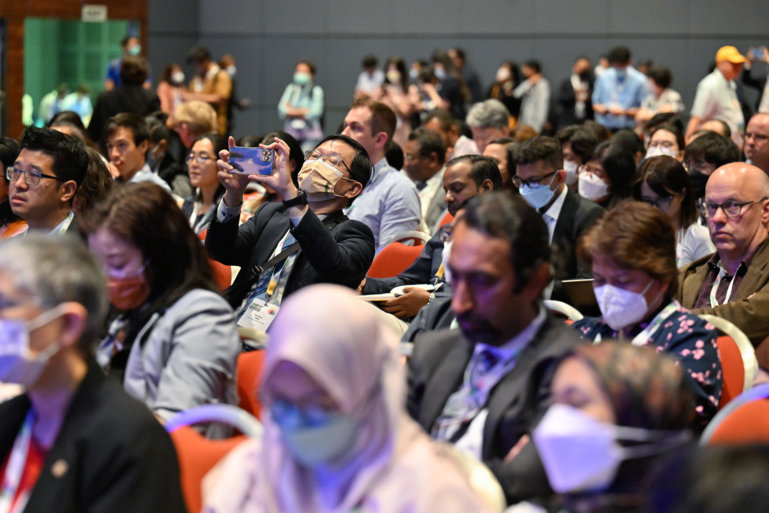While locally tailored cancer screening programmes, particularly for cervical cancer, are showing encouraging results in some areas with limited resources, cancer care is still suffering some bottlenecks due to lack of training for healthcare staff and shortages of medicines
“Implementing screening and immunisation programmes for cervical cancer and establishing pathways for early diagnosis of other common cancers is achievable in low- and middle-income countries. It is not about buying expensive equipment, it is about training doctors and nurses to do the basics, and then organising the care,” says Dr Peter Vuylsteke, University of Botswana, Gaborone.
The Belgian oncologist from CHU UCL Namur, Namur, Belgium, moved to Botswana in December 2019, on a three-year contract with the University of Botswana and is one of a handful of oncologists working in the African country.
A new national cervical cancer screening programme, based on visual inspection following addition of vinegar to the cervix, started in 2012. Since 2015, human papilloma virus (HPV) immunisation for girls aged nine to 13 has been very successful, though, as in many countries, the Botswana programme does not yet extend to boys.
“Despite our screening programme, we still see a lot of advanced cervical cancer and this means that the eradication of cervical cancer is not just about effective screening and vaccination, it is also about what comes afterwards", says Vuylsteke.
If it takes a year for women to get treatment after a positive screening test, their cancer is likely to be invasive and much harder to treat successfully.
According to a report discussing results pertaining to cervical cancer from the 2017 WHO Non-Communicable Disease Country Capacity Surveys, only one in three LMICs offered HPV vaccination against cervical cancer in 2017, despite the disease being the leading cause of death in many of these countries. Results where different in other areas where vaccination was offered in 80% of high-income countries and in nearly 50% of upper-middle-income countries. Across all 194 countries in the survey, cervical cancer screening was available in at least three-quarters but there were significant gaps in treatment, early diagnosis and palliative care, especially in Africa. Among countries with HPV screening, treatment was missing in 13%, early diagnosis guidelines in 13%, and palliative care in 40%. In the African region, this discord was even greater: 32%, 17% and 60%, respectively. The report concluded that, especially in settings where resources are limited, it will be important not just to expand services but to ensure symmetric and concordant development of each service related to cervical cancer (ESMO Open 2020 Nov;5(6):e000878).
Lead author of the analysis, Prof. Laurie Elit, McMaster University, Hamilton, Canada, explains that high income countries in the survey were more likely to have implemented the WHO’s recommended ‘Best Buy’ cancer interventions. These evidence-based interventions, which are considered highly cost effective, feasible and appropriate for LMICs, are screening and treatment of pre-cancerous lesions and HPV immunisation to prevent cervical cancer.
“It is clear that unless you have structures such as essential health or primary care packages in place, and the political will to bring money to the table to implement them, you are going to see gaps in care,” says Elit.
Investing in primary care
In November 2020, the World Organization of Family Doctors and four other organisations launched the “30 by 2030” Campaign calling for international donors to assign 30% of their disease-oriented budgets to strengthen primary care systems by 2030 (Bulletin of the World Health Organization 2020;98:812-814).
“Investing in primary care will help to improve symptom recognition and early diagnosis of cancer and other serious diseases and establish a standard of care that will continue after a funding programme ends. Effective funding in primary care will also reduce the brain drain of doctors moving from primary to secondary care in LMICs in search of better conditions,” says Vuylsteke.
With only four public oncology centres in Botswana and patients spread across a country similar in size to France, an effective primary care service is essential to enable investigations to be carried out closer to where patients live.
“In Botswana, we do not have the luxury of investigations such as fine needle aspiration for breast cancer diagnosis being done by radiologists. It is essential to train primary care clinicians in this and other diagnostic techniques and an implementation programme has been set up to do this,” adds Vuylsteke.
The Belgian oncologist is currently collaborating on an innovative project which will enable primary care clinicians to test node samples obtained through fine needle aspiration in artificial intelligence-guided machines (NCT04119154). These are capable of identifying breast cancer cells and detecting hormone receptor positive cells within 30 minutes.
“It is a mobile machine, which makes it easy to use and, if we can validate the technique, it can be used to quickly identify patients who need to be referred for tertiary care so they can avoid all the delays of the standard referral system,” he says.
In another programme carried out with Harvard University, Vuylsteke is testing an optimised cancer prevention programme in 20 local communities, based on disease awareness education, help with accelerating diagnosis, and rapid follow-up of results and treatment for patients. “We are hoping to show that implementation of the whole pathway – prevention, early referral and treatment – can improve outcomes compared with what is currently done,” he says.
Government-funded education initiatives for prevention of common cancers in Botswana including self-examination for breast cancer, condom use and male circumcision, smoking and alcohol awareness have been well received, with traditional healers also proving valuable advocates for local schemes. But, as in many LMICs, there is now a need to identify and address existing bottlenecks in care pathways which may significantly delay cancer care.
The importance of a National Cancer Plan
The WHO defines a National Cancer Control Plan as ‘a public health programme designed to reduce cancer incidence and mortality and improve quality of life of cancer patients, through the systematic and equitable implementation of evidence-based strategies for prevention, early detection, diagnosis, treatment, and palliation, making the best use of available resources’ (WHO).
Elit and Vuylsteke agree that establishing a National Cancer Plan (NCP) is essential for ‘joined up’ care if patients diagnosed with cervical, breast or other cancers through screening programmes are to get timely treatment.
“A National Cancer Plan provides a framework in which you can build effective, consistent services and training with appropriate funding. It enables the Ministry of Health to roll out the same programmes to hospitals and community health centres so that everyone provides cancer care and education in the same way,” says Elit.
In Mongolia, a country of 2 million people spread over a very large area, she was involved in developing an overarching NCP, thanks to a Millennium Challenge grant from the US government. This was followed by individual programmes for cervical and breast cancer, diabetes and hypertension care including a fully supported cervical cancer prevention programme led by the Mongolian authorities.
“We were able to go out and survey exactly what was needed and then put in place all those resources from Pap smear supplies to colposcopes, and provide training for nurses, family doctors, cytologists, and gynaecologists. A national database was created and implemented with a call and recall system. We were also able to assess public understanding so that educational programmes could be introduced to address any misunderstandings,” says Elit.
“In 2015, when I was last there, they had not yet reached the 70% target for cervical screening but they had made substantial progress and the success of the project just shows what can be achieved when everyone gets around the table and works together,” she adds.
Detailed budget planning and resource allocation are major challenges, but existing tools can be applied to help estimate the costs of proposed strategies aimed at providing cancer services that incorporate relevant elements of effective care.
Without an in-depth analysis of a country’s needs, resulting in a structured National Cancer Plan that takes account of variables including available services and cancer burden, governments are unlikely to achieve their goals.
In Botswana, Vuylsteke is currently working with Rutgers University, New Jersey, USA on a Cancer Needs Assessment, gathering information from oncologists, clinicians, patients and caregivers about what is needed for cancer prevention and other services.
“Once we have gathered these perceptions we can draw up an updated NCP for providing these services, so that we can present them to government and hopefully agree on an implementation strategy,” he says.
The need for oncology training in LMICs
While the need for better education in cancer prevention for medical oncologists is increasingly recognised worldwide, the priority in LMICs is to extend training opportunities at all levels of cancer care.
Elit explains that having an NCP in place also brings opportunities for funded training projects within LMICs involving oncologists, surgeons and nurses to technicians and equipment cleaners. For example, the International Gynecology Cancer Society (IGCS) is partnering with the MD Anderson Cancer Center, Houston, USA, to provide training and monthly case reviews for clinicians in LMICs through Project ECHO (Extension for Healthcare Community Outcomes) (Project ECHO).
“When these oncologists, pathologists and other specialists from high-income countries discuss cases on Zoom with clinicians in countries such as Kenya, Kazakhstan, Belarus and Cameroon, they start to understand the limitations of working in LMICs. Together, they problem solve issues such as lack of availability of drugs that we take for granted in high resource settings and consider how substitutes could be used to improve patient care,” says Elit.
“In some settings, telemedicine processes are in place so clinicians can also send radiological images or pathology slides for assessment, as resources are not available to get results locally,” she adds.
In Cameroon, where Elit is currently based, an ECHO cervical cancer prevention programme of telementoring launched in 2018 has attracted considerable interest from nurses undergoing training in cervical cancer prevention and treatment of precancerous lesions (Int J Gynecol Cancer 2018; 29(9):1446-1447). Elit is working with Cameroon Baptist Convention Health Services which have run a cervical screening programme for 11 years using visual examination with vinegar and, in half of centres, HPV self-testing. She is based at Mbingo Hospital where complex cancer surgeries are performed and surgical and medical training is provided.
Funding for cancer care
Many LMICs also have the competing demands of other infectious diseases such as HIV-AIDs and the growing health impact of unhealthy lifestyles like smoking, poor nutrition and alcohol, which may further affect resource allocation on cancer screening programmes.
Vuylsteke is in favour of greater alignment between cancer care and HIV-AIDs care and points out that in Botswana, where the prevalence of HIV is over 50% in people over 50, cancer is now the major cause of death in those living with HIV.
“Funding could be shared between HIV and cancer, especially in primary care. It is possible to put more effort into cancer prevention through the HIV programmes which are already very active and well-funded. Looking ahead, it could make a big difference to what can be achieved in many LMICs where both diseases are common,” he says.
Vuylsteke has found the ESMO-Magnitude of Clinical Benefit Scale (ESMO-MCBS) a valuable tool in establishing the value of anti-cancer drugs and for helping Botswana authorities to decide which agent to fund in public hospitals.
“If a drug scores very high on the ESMO-MCBS it is easier to support using it in Botswana. As the scale is objective it also helps avoid suggestions that a drug is being chosen because of potential links to the manufacturer,” he says.
According to the oncologist, in the short term the emphasis for cancer funding should be on early diagnosis and treatment, especially of cervical, vulvar, breast and colon cancers, whilst continuing the ongoing screening programmes. “Botswana has been a pioneer in HIV care, it now has the opportunity to be the same in cancer care,” he concludes.







